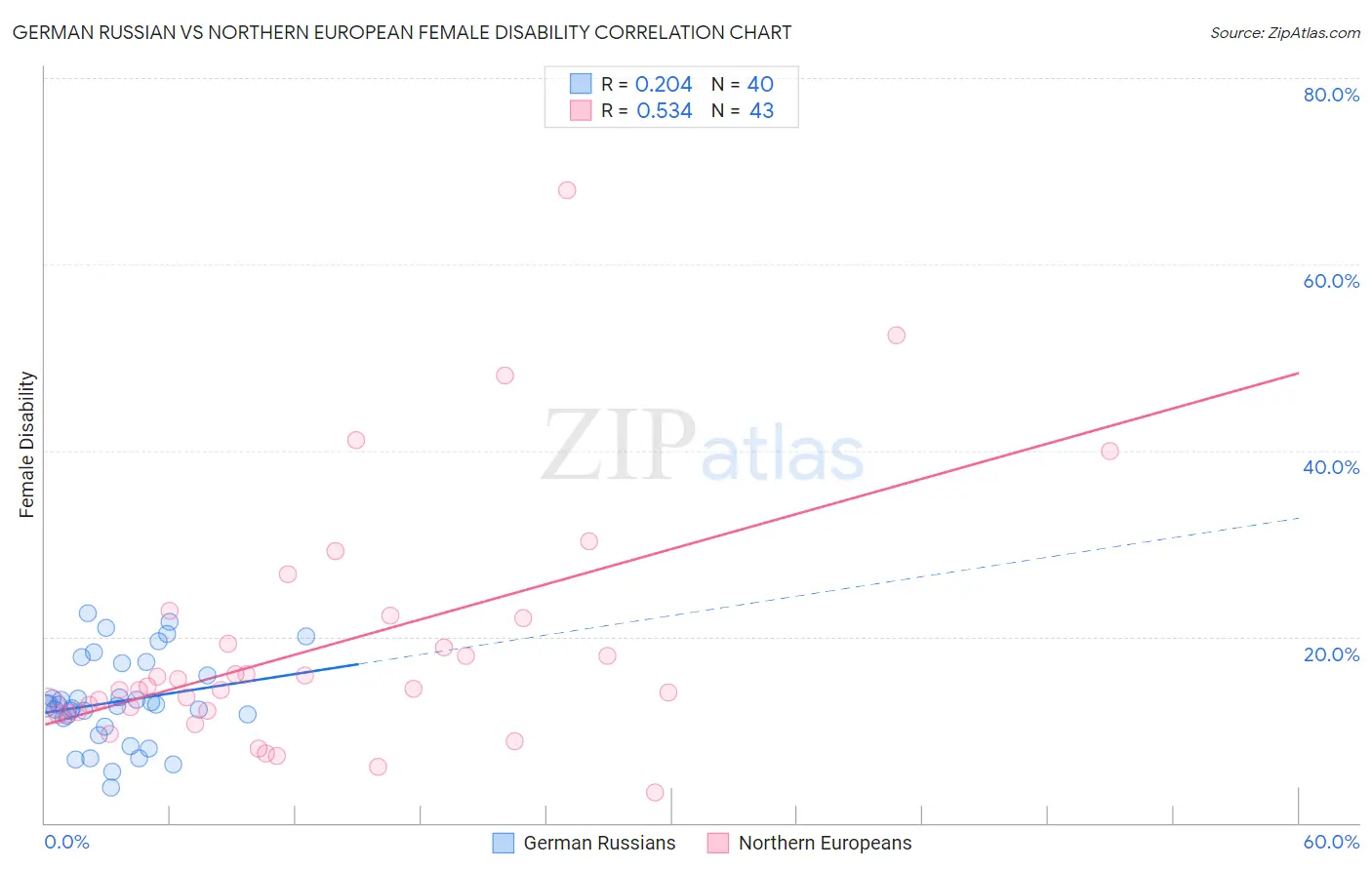German Russian vs Northern European Female Disability
COMPARE
German Russian
Northern European
Female Disability
Female Disability Comparison
German Russians
Northern Europeans
12.6%
FEMALE DISABILITY
3.2/ 100
METRIC RATING
240th/ 347
METRIC RANK
12.3%
FEMALE DISABILITY
27.5/ 100
METRIC RATING
193rd/ 347
METRIC RANK
German Russian vs Northern European Female Disability Correlation Chart
The statistical analysis conducted on geographies consisting of 96,458,530 people shows a weak positive correlation between the proportion of German Russians and percentage of females with a disability in the United States with a correlation coefficient (R) of 0.204 and weighted average of 12.6%. Similarly, the statistical analysis conducted on geographies consisting of 406,028,817 people shows a substantial positive correlation between the proportion of Northern Europeans and percentage of females with a disability in the United States with a correlation coefficient (R) of 0.534 and weighted average of 12.3%, a difference of 2.3%.

Female Disability Correlation Summary
| Measurement | German Russian | Northern European |
| Minimum | 3.8% | 3.3% |
| Maximum | 22.6% | 68.0% |
| Range | 18.8% | 64.7% |
| Mean | 13.0% | 18.9% |
| Median | 12.6% | 14.4% |
| Interquartile 25% (IQ1) | 10.8% | 12.0% |
| Interquartile 75% (IQ3) | 16.5% | 22.0% |
| Interquartile Range (IQR) | 5.7% | 10.0% |
| Standard Deviation (Sample) | 4.7% | 13.1% |
| Standard Deviation (Population) | 4.6% | 13.0% |
Similar Demographics by Female Disability
Demographics Similar to German Russians by Female Disability
In terms of female disability, the demographic groups most similar to German Russians are Barbadian (12.6%, a difference of 0.090%), Yugoslavian (12.6%, a difference of 0.13%), Slavic (12.6%, a difference of 0.15%), Japanese (12.6%, a difference of 0.17%), and Canadian (12.6%, a difference of 0.22%).
| Demographics | Rating | Rank | Female Disability |
| Immigrants | Iraq | 5.3 /100 | #233 | Tragic 12.5% |
| Scandinavians | 5.3 /100 | #234 | Tragic 12.5% |
| Malaysians | 5.0 /100 | #235 | Tragic 12.5% |
| Immigrants | West Indies | 4.4 /100 | #236 | Tragic 12.6% |
| Slavs | 3.8 /100 | #237 | Tragic 12.6% |
| Yugoslavians | 3.7 /100 | #238 | Tragic 12.6% |
| Barbadians | 3.6 /100 | #239 | Tragic 12.6% |
| German Russians | 3.2 /100 | #240 | Tragic 12.6% |
| Japanese | 2.7 /100 | #241 | Tragic 12.6% |
| Canadians | 2.6 /100 | #242 | Tragic 12.6% |
| Immigrants | Senegal | 2.5 /100 | #243 | Tragic 12.6% |
| Alsatians | 2.5 /100 | #244 | Tragic 12.6% |
| Immigrants | Jamaica | 2.2 /100 | #245 | Tragic 12.6% |
| Spanish American Indians | 2.1 /100 | #246 | Tragic 12.6% |
| Menominee | 2.1 /100 | #247 | Tragic 12.6% |
Demographics Similar to Northern Europeans by Female Disability
In terms of female disability, the demographic groups most similar to Northern Europeans are Ukrainian (12.3%, a difference of 0.010%), Swedish (12.3%, a difference of 0.040%), Immigrants from Western Africa (12.3%, a difference of 0.080%), Armenian (12.3%, a difference of 0.10%), and Immigrants from Panama (12.3%, a difference of 0.10%).
| Demographics | Rating | Rank | Female Disability |
| Austrians | 33.3 /100 | #186 | Fair 12.3% |
| Serbians | 33.1 /100 | #187 | Fair 12.3% |
| Immigrants | North America | 32.8 /100 | #188 | Fair 12.3% |
| Immigrants | Albania | 31.6 /100 | #189 | Fair 12.3% |
| Immigrants | Honduras | 31.3 /100 | #190 | Fair 12.3% |
| Armenians | 29.7 /100 | #191 | Fair 12.3% |
| Immigrants | Western Africa | 29.2 /100 | #192 | Fair 12.3% |
| Northern Europeans | 27.5 /100 | #193 | Fair 12.3% |
| Ukrainians | 27.2 /100 | #194 | Fair 12.3% |
| Swedes | 26.6 /100 | #195 | Fair 12.3% |
| Immigrants | Panama | 25.5 /100 | #196 | Fair 12.3% |
| Hondurans | 25.4 /100 | #197 | Fair 12.3% |
| Mexican American Indians | 24.9 /100 | #198 | Fair 12.3% |
| Immigrants | Trinidad and Tobago | 24.7 /100 | #199 | Fair 12.3% |
| Trinidadians and Tobagonians | 22.4 /100 | #200 | Fair 12.3% |